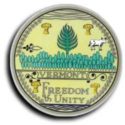Less than three years after the U.S. Constitution was ratified in 1788, Congress for the first time exercised its power under Article IV, Section 3 to admit a new state to the union. In 1791, Congress accepted the petition of the Vermont territory to become a state, and President Washington proclaimed it the 14th state of the union on March 4, 1791.
This action ended an open conflict that began during the colonial period, in which the people of what became Vermont defied the attempts of the governments of New Hampshire and New York to rule the territory. Instead, the people of the territory were among the first to seek independence from Britain’s colonial regime in America.
Led by Ethan Allen and backed by his Green Mountain Boys militia, the people named the territory “New Connecticut” and declared independence against rule by either the colonial government of New York or England. They drew up a constitution, ended slavery, gave the vote to all male citizens, and even went through the motions of seeking recognition of independence by the British. When the Crown refused to acknowledge their independence, the militia under Allen joined the rebellion against British rule and fought with valor in decisive battles of the American Revolution.
Ethan Allen was one of the great heroes of the American Revolution — but he and his troops joined the Americans only after making their own declaration of independence separate from the Declaration of Independence adopted by the 13 colonies.
Even during the period when it was negotiating admission to the union with New York and the U.S. Congress, Vermont boldly and brashly asserted its independence and its right to negotiate with England. Vermont even hinted at re-alignment with England if it could not negotiate acceptable terms of admission with New York and the U.S. government.
For 15 years the intrepid people of the rogue territory and their leaders played New York, New Hampshire, Britain and the Continental Congress off against each other. They achieved functional self-government and autonomy, even though they weren’t recognized as an independent state. In the end it was not Vermont but the legislature of New York that changed its position and agreed to a settlement of the dispute over Vermont’s status. Congress recognized that Vermont was part of New York, but New York accepted the will of Vermont’s people to become a state of the union.
Vermont’s struggle for independence led to statehood, and the history of Vermont shows that statehood was the best way to achieve the self-government the people of Vermont wanted. Through equal rights of statehood and citizenship in the United States, Vermont gained what it was never able to achieve as an independent nation. Puerto Rico’s independence party today seeks to go back in time before the people chose U.S. citizenship as the basis for political union with the United States as a commonwealth under federal territorial law.
Instead, those in the territory who seek separate nationhood advocate a status that will end to U.S. nationality and citizenship. That remains possible, but not realistic. With only 5% voting for independence in the last referendum, it is clear that the people of Puerto Rico don’t want independence. Puerto Rico, like Vermont, has the opportunity to gain real autonomy and permanent political union as a state.
Paths to Statehood, Part I: The First 13
This post was originally written in English and may be being auto-translated by Google.








3 Responses
[…] the first thirteen original states ratified the U.S. Constitution, Vermont, an area claimed by the State of New York, was admitted to the Union in 1791 with that state’s […]
[…] States, too. In 2011, Puerto Rico paid $3.3 billion in taxes to the U.S., about the same amount as Vermont. Sometimes Puerto Rico pays more than […]
[…] their own State, it would not have been impossible for them to do so. Several States, including Vermont, Kentucky, and West Virginia had previously been claimed by other States. Western Illinois […]